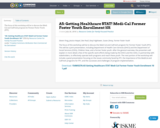
The focus of this workshop will be to discuss the Medi Cal and CalFresh program for Former Foster Youth (FFY).
- Subject:
- Social Science
- Material Type:
- Lecture Notes
- Date Added:
- 06/14/2016

The focus of this workshop will be to discuss the Medi Cal and CalFresh program for Former Foster Youth (FFY).

This course presents real-world examples in which quantitative methods provide a significant competitive edge that has led to a first order impact on some of today’s most important companies. We outline the competitive landscape and present the key quantitative methods that created the edge (data-mining, dynamic optimization, simulation), and discuss their impact.

In this activity, students will be given a task to practice a conversation on what to say if they were either a doctor or patient, along with using hospital vocabulary and the لـ، مع، عند grammar.Can-Do Statements:I can identify and describe parts of the body.I can describe my condition to the doctor.I can listen to and understand doctors' prescriptions.I can explain in simple words to help others understand the solution(s) I’m giving.

This course explores successful approaches to delivering healthcare in challenging settings. We analyze organizations to find why some fall short while others grow in size and contribute to the health of the people they serve, and explore promising business models and social enterprise innovations.

This course provides an introductory survey of data science tools in healthcare. It was created by members of MIT Critical Data, a global consortium consisting of healthcare practitioners, computer scientists, and engineers from academia, industry, and government, that seeks to place data and research at the front and center of healthcare operations.
The most daunting global health issues right now are the result of interconnected crises. In this course, we highlight the importance of a multidisciplinary approach to health data science. It is intended for front-line clinicians and public health practitioners, as well as computer scientists, engineers, and social scientists, whose goal is to understand health and disease better using digital data captured in the process of care.
What you’ll learn:
Principles of data science as applied to health
Analysis of electronic health records
Artificial intelligence and machine learning in healthcare
This course is part of the Open Learning Library, which is free to use. You have the option to sign up and enroll in the course if you want to track your progress, or you can view and use all the materials without enrolling.

This design course targets the solution of clinical problems by use of implants and other medical devices. Topics include the systematic use of cell-matrix control volumes; the role of stress analysis in the design process; anatomic fit, shape and size of implants; selection of biomaterials; instrumentation for surgical implantation procedures; preclinical testing for safety and efficacy, including risk/benefit ratio assessment evaluation of clinical performance and design of clinical trials. Student project materials are drawn from orthopedic devices, soft tissue implants, artificial organs, and dental implants.
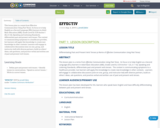
This lesson plan is a remix from Effective Communication Using Past Tense. Its focus is to help English as a Second Language (ESL) learners in Adult Basic Education (ABE), Grade Level B, CCR Anchor 1 (SL.3.1-1d), Speaking and Listening Standards, differentiate past and present verb tenses. The context is communicating symptoms to a healthcare provider, but learners will apply this knowledge to create new knowledge in other contexts. Learners will engage in collaborative discussions (one-on-one, group, and instructor-led) with diverse partners, build on others' ideas, ask questions, and practice verbal and written use of past and present verb tenses.
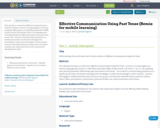
This activity is a remix from Effective Communication Using Past Tense. Its focus is to help English as a Second Language (ESL) learners in Adult Basic Education (ABE), Grade Level B, CCR Anchor 1 (SL.3.1-1d), Speaking and Listening Standards, differentiate past and present verb tenses. The context is communicating symptoms to a healthcare provider, but learners will apply this knowledge to create new knowledge in other contexts. Learners will understand past and present verb tenses, irregular and regular past tense verbs, and practice identifying the verbs.

This course provides a comprehensive review of interoperability, health data standards, and other advanced topics including Substitutable Medical Applications, Reusable Technologies (SMART) and Fast Healthcare Interoperability Resources® (FHIR), also known as SMART-on-FHIR applications and Accelerator projects. This course will use Interoperability Land™ to provide learners with a hands-on experience using FHIR resources. Upon successful completion of this course, learners will be able to: explain interoperability and use cases; locate information within JSON and XML files; Create queries in IOL; understand SMART application authorization. Interoperability Land can be purchased on AWS Marketplace at the followinglink: https://aws.amazon.com/marketplace/pp/prodview-f34r2uj3naohe For information regarding education pricing please email contactus@interoperabilityinstitute.org.

In this three-day workshop, students will get a broad introduction to global health issues. We will look at one particular non-governmental organization in India that works to improve health across the lifespan by empowering existing community resources to provide appropriate physical, psychological and social therapies, focusing on child development, adolescent and youth health, mental health, and chronic disease. This workshop equips student to explore novel ideas and technologies with an inspiring and ground-breaking Indian NGO.
Fulfills the Sloan Innovation Period (SIP) elective requirement. SIP occurs at the midpoint of each semester providing students with an intensive week of experiential leadership learning, as well as exposure to groundbreaking faculty work. It allows students to engage in intellectual exploration outside the classroom. SIP degree requirements include core courses in ethics and leadership as well as electives.

This course pairs faculty-mentored student teams with enterprises on the front lines of health care delivery in sub-Saharan Africa and South Asia. To tackle specific barriers identified by each partnering organization, the course is built around custom-designed projects in strategy, business model innovation, operations, marketing, and technology. Class sessions include interactive cases, practical exercises, and lively conversations with experts, all designed to support project work before, during, and after the intensive two-week onsite collaboration with entrepreneurs, leaders, staff, and stakeholders in the setting. Course assignments include a portfolio of host deliverable, a foundational toolkit designed to support each project, and a distillation of learning from the field.
Acknowledgements
Special thanks is given to Imperial Health Sciences, Unjani Clinic and L V Prasad Eye Institute for allowing their organizations to be featured in the sample student projects on this course site.

This micro-credential is designed to equip healthcare professionals with essential skills and knowledge to excel in their roles by emphasizing the importance of professionalism and customer service. Effective time management and organizational strategies will be covered. Students will explore the importance of personal appearance, positive attitude, and ethical behavior in healthcare. The topics of bias, prejudice, ethnocentrism, and cultural competence will be covered, all of which are essential for providing high-quality, patient-centered care. This micro-credential is part 2 of 3 of the Professionalism in Healthcare Series. ( Part 1 – Patient Centered Communicator, Part 3 – Teamwork & Interprofessional Collaborator) Content is accesible in the SCORM file

This course introduces students to machine learning in healthcare, including the nature of clinical data and the use of machine learning for risk stratification, disease progression modeling, precision medicine, diagnosis, subtype discovery, and improving clinical workflows.

This instance of “Media, Education, and the Marketplace” focuses on the rise of information and communications technologies (ICTs) during the age of globalization, specifically examining its effect and potential in developing nations across the world. In particular, the class will focus on the following three components:
“Media” – ICTs, specifically the dramatic rise in use of the Internet over the past twenty years, have “globalized” the world and created opportunities where very few have been available in the past. We are entering a phase where an individual can significantly improve his or her own economical, political, and social circumstances with just a computer and Internet connection. This course investigate these profound developments through current research and case studies.
“Education” – With projects such as MIT’s OpenCourseWare, the major players in the world are beginning to understand the true power of ICTs in development. Throughout this class, we examine projects that harness the benefits of ICTs to create positive social change around the world.
“Marketplace” – The focus is on the developing regions of the world. Specifically, the term “digital divide” is tossed around in everyday language, but what does it really mean? Is there an international digital divide, a national digital divide, or both? Should we try to bridge this divide, and how have past attempts succeeded and (for the most part) failed? Why? These are all questions that are asked throughout this course.
This course has a very unique pedagogy, which is discussed in more detail in the syllabus section.

This customized independent study course puts Sloan Fellows MBA students into direct contact with innovators tackling global needs in education, healthcare, and energy/environment. Co-designed projects address low-income markets in the U.S. or globally, focusing on the application of new ideas and technology rooted in MIT innovations or the Boston ecosystem. Every project aims to develop better ways for the right innovations to reach scale, sustainability, and quality, thereby improving lives and uncovering opportunities in underserved markets.
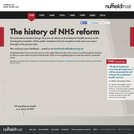
Our interactive timeline brings 70 years of reform to the National Health Service (NHS) to life, charting its evolution from inception through to the present day.
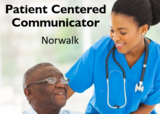
This resource contains a SCORM package (originally hosted in Blackboard LMS), containing the Patient Centered Communicator Micro-credential. This micro-credential is part 1 of 3 in the Professionalism in Healthcare series. (Other parts are Healthcare Professional, and Teamwork & Interprofessional Collaborator, which are posted seperately). This course is fully online, self-led, and takes around 2-3 hours to fully complete at your own pace. It is a professional enhancement level micro-credential. This course could be modified to be instrucor led. Materials and Methods used:This course has been developed in collaboration with healthcare employers and industry professionals. Content mostly consists of powerpoint lectures, supplementary videos, links to articles, and activities and resources. There are multiple choice assessments as well.

14.01 Principles of Microeconomics is an introductory undergraduate course that teaches the fundamentals of microeconomics. This course introduces microeconomic concepts and analysis, supply and demand analysis, theories of the firm and individual behavior, competition and monopoly, and welfare economics. Students will also be introduced to the use of microeconomic applications to address problems in current economic policy throughout the semester.
This course is a core subject in MIT’s undergraduate Energy Studies Minor. This Institute-wide program complements the deep expertise obtained in any major with a broad understanding of the interlinked realms of science, technology, and social sciences as they relate to energy and associated environmental challenges.
Course Format
This course has been designed for independent study. It includes all of the materials you will need to understand the concepts covered in this subject. The materials in this course include:
A complete set of Lecture Videos by Prof. Jon Gruber.
Reading Assignments in your choice of two textbooks – one of which is a free online edition - as preparation for the lectures.
Multiple-choice Quizzes to assess your understanding of the key concepts in each session.
Problem Sets with solution keys to test your ability to apply to concepts covered in lecture, and Problem Solving Videos to provide step-by-step instruction through several problem set solutions.
A collection of links For Further Study to provide supplemental online content.
A full set of Exams, including review material and practice exams to help you prepare.

Private Practice Basics is a training program that all team members must regularly undergo to maintain functional literacy. Among others, functional literacy measures your ability to manage information: obtaining information and synthesizing information (Institute of Medicine, 2004). PediaHealth Basics is administered via Google Classroom. To participate, join the Class.

Example of public health measures used to address pandemics such as covid-19.